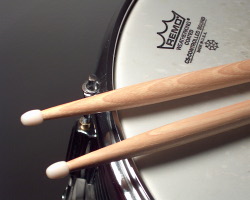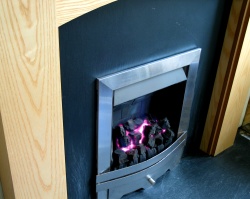How can I soundproof a room reusing and recycling stuff?
 We’ve had an email from Trish:
We’ve had an email from Trish:
My son has recently bought a drum set and we desperately need to sound-proof a room where he can practice. How can we do this using recycled materials?
The old cliché is egg boxes – does that really work though? Waffle foam packaging would probably be slightly better but possibly difficult to source in large enough quantities. I guess egg boxes might be too since the people who tend to have open trays of them – egg sellers or small grocers – tend to reuse them for their original purpose. If egg boxes work, would shaped foam sheets used for packaging round fruit be an alternative?
My boyfriend John, who is a drummer too (although one that doesn’t care too much for soundproofing), has suggested carpet as something good at muffling and easy to source in large pieces. He also suggested cork tiles – the air in the cork structure aids sound deadening apparently.
Another thing I’d add although it’s not really a reuse/recycle thing is, if possible, try placing the drum kit in different parts of the room/house. Some sounds – footsteps, creaking floorboards, John jiggling his legs – really travel around our house but only from/to certain spots. I suspect it’s a joists/floor board thing but don’t know any more than just suggesting trial and error – anyone know why it’s like that?
Any other suggestions?























I know why it’s like that. It’s vibrations. Vibrations at certain pressures on certain materials resonate. Kind of like a tuning fork. Or that bit of the car that only buzzes when you’re on the motorway.
When in comes to foam – there is lots in my local scrapstore – maybe you could try yours. I found this interesting article on Wikipedia: http://en.wikipedia.org/wiki/Soundproofing
the most interesting bit to me being that you can turn sound energy into heat. Maybe your son could cut down your heating bill at the same time!
Heavy curtains sounds the most promising reusable one. (though neoprene is interesting – you’d have to cut up a lot of wetsuits!)
I read a few articles on soundproofing before posting this but forgot to check the ever-reliable ‘pedia — thanks for the link, Caroline :)
Hiya Louisa!
If you have loads of Ferrero Rocher boxes randomly lying about you could use those?
You probably want to lift the kit off the floor, particularly if the room is not on the ground floor. Can you get some off-cuts of thick underlay/carpet to go underneath the kit? Can you also get some old palettes to make a raised platform?
As for the room itself I always thought if I needed to soundproof a room cheaply the first thing to try would be to unbox all our books and stack them against the walls.
The egg box thing and the bobbly foam is about breaking up the sound waves, so anything soft and asborbent with a rough or undulating texture would work surely, but what about fire proofing?
I was always stuck with using felt-headed or brush style sticks, or muffling the drums themselves! Old mousepads on the drum heads works just as well as the commercial rubber drum mufflers. If you can get the egg-crate type foam mattress pads (I see them at the thrift store sometimes), those would help soundproof the room with a fairly low fire risk.
This article shows many different types of sticks, including the brushes in one of the side pictures about halfway down. New sticks might be cheaper and more effective than makeshift soundproofing! http://en.wikipedia.org/wiki/Percussion_mallet
A friend of mine came up with an awesome solution. He went around town and picked up all of the white styrofoam packaging he could find. Its the kind of stuff you’d find boxed in with a microwave oven or TV, any shape, any size, but the big flat pieces with wonky bits worked the best. Then he positioned it on his walls like an artistic mosaic, covering as much as the wall space as he could. It looks awesome, sort of like the inside of an Apollo spaceship, and it absorbs a whole lot of sound.
The hint about getting the kit off the floor is a good one, too. Carpeting helps, as well.
Good Luck!
I don’t have any experience of soundproofing, but if eggboxes are good just hard to cover a large area with – how about those trays that apples and oranges are laid out in in supermarkets? They give them out in the cardboard box areas usually.
All these suggestions treat the acoustic properties of the inside of the room. True “soundproofing” requires much more intentional structural effort. One primary tip is this – if air can get through then sound can get through too.
(I’ve built 3 recording studios in California). Good luck.
I agree with mark, “All these suggestions treat the acoustic properties of the inside of the room. True “soundproofing” requires much more intentional structural effort.”
I have read that Quietrock and quietglue work the best for high STC – and ultimately you are saving material and floorspace vs resilient channel.
try your local mattress recycling depot, they usually have the plastic foam sheet for sale super inexpensive
U also can use old carpet and coak or simenboard
Thanks to all for a sharing :-)
Magnificent Piece
I dislike reading long articles, only as i’ve got a bit of dislexia, but i really
loved this post
Putting packing materials, like spiked foam, egg cartons, or Styrofoam, on walls almost always results in a potentially horrific fire hazard (Google “Station nightclub fire West Warwick” if not convinced). If you control your walls and there is space available in them, you can improve their absorption a lot by packing them tightly with just about any insulation; even old clothes will work, but dip them in plaster or mortar to reduce any possible fire hazard. This can wok wonders even in single-studded walls, but it must be packed tightly to create the friction needed to convert the sound to heat; fluffed up insulation you would normally find in exterior walls won’t do.